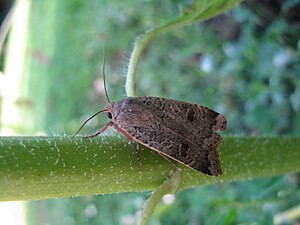Noctua interposita
| Noctua interposita | ||||||||||||
|---|---|---|---|---|---|---|---|---|---|---|---|---|

Noctua interposita |
||||||||||||
| Systematics | ||||||||||||
|
||||||||||||
| Scientific name | ||||||||||||
| Noctua interposita | ||||||||||||
| ( Huebner , 1790) |
Noctua interposita is a species of butterfly fromthe owl butterfly family (Noctuidae). The species was only (again) recognized by Boursin in 1963, after having been regarded as a synonym of N. orbona for a long time.
features
The wingspan of the moth is 39 to 45 millimeters. The color of the forewings varies from light brown to dark brown to reddish brown. Cross lines and flaws (ring and kidney flaws) are usually clearly drawn. The blemishes are usually a little darker and often outlined in white. The cross lines can be lighter or darker than the base color. Often darker cross lines have a light border. The hind wings are yellow with a black marginal band. The black, crescent-shaped discal spot is clearly drawn. The early stages are poorly known.
The egg is hemispherical with a flattened base. It measures 0.5 to 0.5 mm in height and 0.6 to 0.7 mm in diameter. The upper two thirds of the surface have approx. 30 wide and distinct longitudinal ribs that intersect with weaker transverse ribs. Most of the transverse ribs do not extend to the micropyl region.
The caterpillar is said to be "livelier" in color than the Noctua orbona caterpillar .
Similar species
Noctua interposita differs from Noctua orbona in the following features : The middle transverse line is laid out white at its beginning at the costal edge, the costal spot at the end of the wavy line is dark brown, not deep black and not sharply delimited towards the base of the wing. On the yellow hind wings, the dark band and the crescent-shaped central spot are slightly wider. In Noctua comes this spot is missing or is only diffuse light to dark brown. Usually, cross lines and blemishes are more clearly developed in Noctua interposita than in Noctua orbona and Noctua comes . The species can be clearly distinguished by means of a genital examination .
Geographical distribution and habitat
Because the species was (again) recognized as an independent species relatively late, the distribution area is not sufficiently well known. According to Fibiger, the species should have a Mediterranean- Asian distribution. It has been reliably detected in southern, central and southeastern Europe, but mostly only spotty. But it seems to be missing in the British Isles . In the east and south-east the distribution area includes Turkey , the Caucasus , Armenia , southern Russia and the European part of Kazakhstan and western Siberia . The species is known as the migrant butterfly ; it is therefore repeatedly reported from Sweden as well as from Finland .
The preferred habitat are steppes , dry forest edges as well as warm slopes and river valleys.
Way of life
Noctua interposita forms one generation per year, whose moths fly to warmer regions from May to September, rarely into October. Depending on the region, the moths rest for different lengths of time. The moths are nocturnal and come to artificial light sources . They visit flowers and can also be baited . The caterpillars can be found from August. They overwinter and pupate mostly in April of the following year. They feed on the leaves of various herbaceous plants and grasses .
Danger
Since Noctua interposita has not long been known as an independent species and can easily be confused with other species, its distribution in Germany is still insufficiently documented. On the Red List of Threatened Species it is classified in category G (endangered, but status unknown).
swell
Individual evidence
- ↑ Axel Steiner in Ebert (1998: p. 366)
- ↑ a b Fibiger (1993: p. 79)
- ↑ Dolinskaya & Geryak (2010: p. 20/1)
- ↑ a b Forster & Wohlfahrt (1971: p. 312/3)
- ↑ Boyan Zlatkov: Butterflies and moths (Lepidoptera: Macrolepidoptera) of Mesta Valley in SW Bulgaria. Historia naturalis bulgarica, 18: 95–126, 2007 PDF ( Memento of the original from January 13, 2016 in the Internet Archive ) Info: The archive link was inserted automatically and has not yet been checked. Please check the original and archive link according to the instructions and then remove this notice.
- ↑ Hermann Hacker and Jan Miatleuski: Noctuidae from the European part of Kazakhstan with first records of seven species for the European fauna. Esperiana, 8: 811-824, Schwanfeld 2001
- ↑ GS Zolotarenko and VV Dubatolov: A check-list of Noctuidae (Lepidoptera) of the Russian part of the West Siberian plan. Far Eastern Entomologist, 94: 1-23, 2000 ISSN 1026-051X PDF
- ↑ M. Lindeborg: Remarkable records of Macrolepidoptera in Sweden 2005. Entomologisk Tidskrift, 127 (1-2): 61-71, 2006 ( page no longer available , search in web archives ) Info: The link was automatically marked as defective. Please check the link according to the instructions and then remove this notice.
- ↑ SJ Coulson, ID Hodkinson, NR Webb, K. Mikkola: Aerial colonization of high Arctic islands by invertebrates: the diamondback moth Plutella xylostella (Lepidoptera: Yponomeutidae) as a potential indicator species. Diversity and Distributions, 8: 327-334, 2002 doi : 10.1046 / j.1472-4642.2002.00157.x
- ↑ a b Manfred Koch : We identify butterflies. Volume 3: Owls. 2nd, expanded edition. Neumann, Leipzig / Radebeul 1972, DNB 760072930 .
- ↑ Red lists at Science4you
literature
- IV Dolinskaya, Yu. A. Geryak: The Chorionic Sculpture of the Eggs of Some Noctuinae (Lepidoptera, Noctuidae) from Ukraine. Vestnik zoologii, 44 (5): 421-432, 2010 doi : 10.2478 / v10058-010-0028-4
- Michael Fibiger: Noctuidae Europaeae, Volume 2 Noctuinae II. Entomological Press, Sorø, 1993, ISBN 87-89430-02-6
- Walter Forster , Theodor A. Wohlfahrt : The butterflies of Central Europe. Volume 4: Owls. (Noctuidae). Franckh'sche Verlagshandlung, Stuttgart 1971, ISBN 3-440-03752-5 .
- Axel Steiner and Günter Ebert: The butterflies of Baden-Württemberg Volume 7, Nachtfalter V (Owls (Noctuidae) 3rd part), Ulmer Verlag Stuttgart 1998. ISBN 3-8001-3500-0
